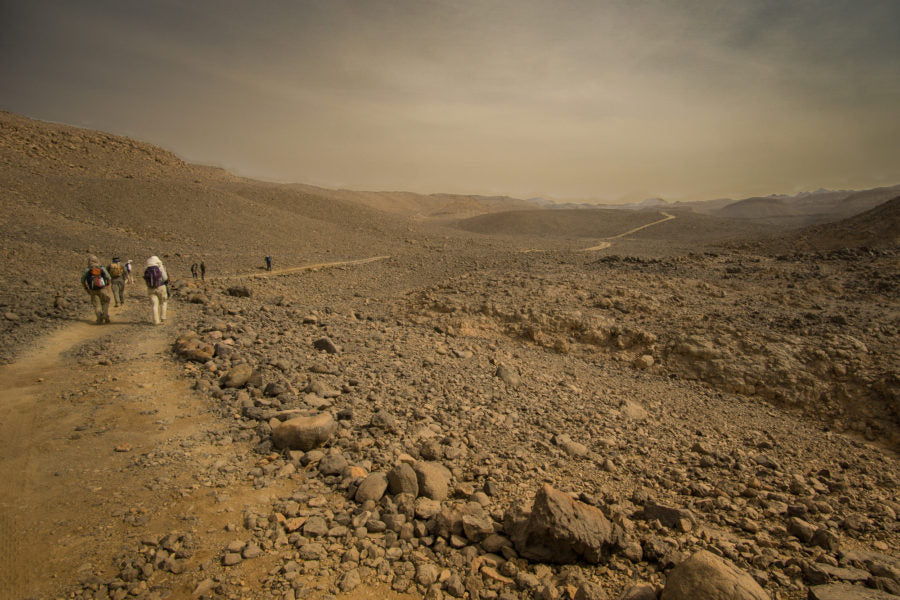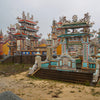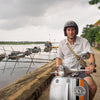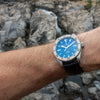On the roof of the Sahara: Summiting Emi Koussi with the Raven Trekker

On the roof of the Sahara: Summiting Emi Koussi with the Raven Trekker
by Alex Williams
In the first few days of 2017 I left London for N'Djamena, the capital city of Chad, to join a Secret Compass team embarking on a grand expedition into the centre of the Sahara.
Our team of 10 would be led by Luca Alfatti, Wanderlust guide of the year and the mastermind behind the expedition. Our plan was to follow in the footsteps of the renowned explorer Wilfred Thiseger, who in September 1938 was the first to summit Emi Koussi, an extinct pyroclastic shield volcano, and at 3,445m/11,302ft, it is the highest point in the Sahara.
A week before embarking on this adventure I had the realization that my Apple Watch would just not cut it. Not only did it need to be charged everyday but I was highly skeptical that it would endure the sand, the temperature and - to be frank - being sweat into everyday for a month. So I decided to look around for an alternative. The obvious choices where of the clunky digital variety or more complex GPS watches. I ruled both out quickly as I prefer not to consolidate expedition functions (altimeter, compass, etc.) in a watch and I couldn't find a GPS-enabled watch that would last longer than a week without needing to be charged.
So I decided to return to analogue, and investigate a dive watch. Dive watches are famous for being bulletproof, and as such are often taken on expeditions around the world. If you look carefully you can see an Omega Marine Chronometer on the wrist of Cousteau and Sir Edmund Hillary is famed for wearing the Rolex Explorer atop Mt. Everest.

In my search for something bulletproof, but also unique, I came across Raven, and their new watch the Trekker 40 which had recently received glowing praise in a review by Worn and Wound and was being positioned as a watch for expeditions. I immediately got in touch with Steve and he was kind enough to expedite a Trekker watch to London only days before I was due to fly out to Chad.
It arrived the evening before I was due to fly and the adventure started early as I had to forge a path through the worst snow London has had this winter to extract the package from a customs depot in East London. Back home, surrounded by North Face duffle bags, factor 50 sun cream, and other odd bits of gear I opened the package and it was exactly what I had been looking for. With limited time before I had to leave I swapped the beautiful oyster-style bracelet for the more desert-friendly grey zulu strap and finished my preparations.
N'Djamena, Chad
It took two days to get to N'Djamena, but by the evening of the second day our team had assembled and we were being briefed by Luca around the pool at the spartan Chez Wou hotel. It turned out that this would effectively be three expeditions, not simply one.
First, we would have to travel in land cruisers from N'Djamena in the South over 1400km to the base of the Tibesti mountain range. This would be slightly more than driving the full length of the UK, from Land's End to John o' Groats. Second, we would leave the Land Cruisers and after negotiating to rent 12 camels from the local Toubou nomads, trek up into the mountains and attempt to summit Emi Koussi. After summiting we would trek back down to a hot spring, and return our camels to their owners. Finally, we planned to drive a further four-to-five days from the oasis back to N'Djamena in time to celebrate.

The Journey North
We rolled out of Chez Wou the following morning in a convoy of four Toyota Land Cruisers laden to the brim with all of the equipment and provisions we would need for a month in the Sahara. Most of the team would be sleeping out under the stars, on nothing but a thin foam mattress wrapped up in a sleeping bag. This reduced our need to bring too much additional camping equipment. But even then the roof racks were still strapped down with food, fuel and other fundamentals as we turned out of the compound and accelerated out of the city limits.
Over the following five days we travelled up through Southern Chad, passing from the city into the countryside, and from the countryside into the Sahel (the transitional area before the Sahara desert, or the pre-desert). Before long we were driving amongst the rolling sand dunes, past desiccated camel skeletons and the occasional abandoned tank. The trip was hard. Much harder than you'd imagine five days sitting in a land cruiser would be. As the roads outside Chad disappeared and we moved off-road we slowed down and began the mammoth task of crossing the entire length of Chad to get to the Tibesti mountains.

In the desert the sun rises and sets in what feels like the space of ten minutes. Every evening we would lose the sun at six and be ready for bed by eight. Then at six o'clock in the morning the sun would split the horizon in two and the stars would shrink away. I remember this distinctly as I would normally wake up in darkness and immediately check my Trekker, the fully lumed bezel glowing blue in the pre-dawn darkness. Time to get up, roll-up the sleeping bag, and get back on the road.

Our only break in the journey came when we stopped at Faya, the largest town in the Saharan region of Chad. We were able to take on additional provisions and most importantly secure passage from the local government to enter the Tibesti region. Thankfully the process went smoothly and taxes paid and passports in hand we were able to leave Faya that very afternoon and head back out into the Sahara in search of water, where the Toubou had made camp and our camels awaited.
The Toubou
In order to reach the summit we would have to first deal with both the bureaucratic and logistical problems involved in crossing a desert mountain range. Luckily our in-country team SVS had liaised with our local guide and arranged for us to meet the Toubou at their village at the base of the volcano. From there we would be able to negotiate for, and rent, twelve camels and their handlers who would be responsible for getting our remaining expedition gear up to the last camp in the caldera of the volcano and back down again. A journey that would take nine days.

This, however, did not go smoothly.
We became quickly aware that the Toubou had decided that we needed to pay much more than we had previously agreed through the local guide. We found out later that this was caused in-part to the increase in gold mining in the Tibesti mountains along the border. The Toubou, who sporadically work with foreigners, saw the mining as much more profitable than spending nine days trekking up Emi Koussi and had raised their prices to reflect this. This was difficult to swallow as we had already agreed to pay 1.5 times the price it would normally cost to purchase twelve camels outright, even though we would only be renting them for nine days.
After a tense evening of negotiation between our local guide, our in-country team and the Toubou we settled on a compromise, splitting the difference on the price and agreeing to hire thirteen camels rather than twelve. With the negotiations complete we prepared to begin the long approach across the flanks of the volcano, through lava fields, and up onto the caldera's ridge.

It would take us four days to reach camp tucked into the side of the volcano just below the ridge. As Emi Koussi is a shield volcano the ridge is long and flat giving us a little shelter from the wind and a place to camp. That night as we unpacked we were able to hike up to the edge of the caldera and stare across its 15km diameter. At almost 500m deep the primary crater is absolutely massive. Offset from its centre and another several hundred metres below the craters floor is the secondary caldera which at this point was still a hole on the horizon. This also was the first time we glimpsed the summit, the highest point on the ridge, and tomorrow's challenge.
The Summit
The original plan was for the team, along with the camels and their handlers to descend into the caldera by a safe route and while the camels settled into camp at the base of the crater we would begin to summit the southern edge to the highest point.

However on closer inspection we found a route that would take the team around the far edge of the caldera and along the top of the ridge to the summit. As far as we knew no other team had attempted this route before, and so we were exited to give it a try. It would take us all morning to circumnavigate the ridge but we were afforded with incredible views of the greater Sahara as far as the eye could see (on the left) and the primary and secondary calderas (on the right).

Just before noon we summited the highest point on the ridge across surprisingly difficult to traverse sandstone rocks and secured our place as the first British team since Thisiger's 1938 ascent to summit Emi Koussi. Standing at the highest point in the Sahara dessert we were able to see across the lava fields, the scree slopes, and the rock valleys, even managing to glimpse in the distance the start of the sand dunes. It was an unforgettable sight.

From here, feeling rather victorious, we embarked on a perilous descent down moving scree slopes to the southern gateway of the caldera where the Toubou had made camp. The following morning, after a night that had unexpectedly dropped to -10º Celsius and frozen the water in our Camelbaks we climbed out of the the caldera and followed the camels on a further three day trek to meet our Land Cruisers at the hot springs at the base of the volcano.
From here it was another five days drive back to N'djamena, an expedition in itself, and a well deserved beer back at Chez Wou.
Closing Thoughts
Being part of the first British commercial team to summit Emi Koussi was more than an expedition, it was a grand adventure, and one that I am very proud to have been able to be a part of.
After almost a month in the Sahara I became incredibly attached to the Trekker as a tool that would not break, seize up or fail under the harsh conditions. I firmly believe that the Trekker is perfectly positioned as not only an excellent dive watch but more importantly a great companion while on an expedition into the unknown. It never ran out of battery, it was a constant talking point (and source of envy) amongst the team, and it shucked off everything the Sahara could throw at it. From its luminous glow as it fed off the light of a thousand stars in the desert night sky, to the screw-down crown that kept it sand-proof, I am indebted to Steve and Raven for supplying me with such a bulletproof timepiece.
Furthermore it was more than a tool. I enjoyed wearing the watch, and it became part of the experience of the expedition. Wearing the watch back in London it reminds me everyday of my adventure in the Sahara. I'm now looking forward to 2018 and seeing how it'll thrive at altitude, 7500m up the highest mountain in Afghanistan. After the Sahara, the Trekker should find this one easy.








